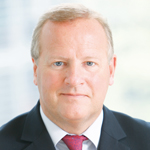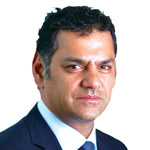Striking the right balance

|
Written By: Andrew Swan |

|
Richard Ryan |
Low yields have been providing challenges for fixed income investors. Richard Ryan explains how M&G Investments tackles the risk/reward conundrum
Over the past few years, institutional investors have had to contend with stiflingly low yields across fixed income assets. As a result, many investors have looked to riskier investments such as high yield bonds as a means of boosting their returns. But just how sensible is it for investors to continue piling into riskier assets? In order to find out how prudent investors can improve their returns in today’s market, Andrew Swan, of M&G Investments’ institutional distribution team, asked Richard Ryan, manager of M&G’s multi-asset credit portfolios.
Andrew Swan (AS): Richard, do you think anything could derail the tremendous rally we’ve seen in high yield over the past few years? What could make the market nervous?
Richard Ryan (RR): Well, let’s start with the three main elements that have made the market strong. Number one is accommodative monetary policy across the US, EU, UK and Japan. The second element is that default rates are low and the third is a perceived improvement in global economic growth prospects.
Now, as to what could make the market nervous – all you’d need is for just one of those three elements to falter. So something like an unexpected change in monetary policy, marginal high yield companies struggling to refinance, or less optimistic economic forecasts could all pose a threat.
The important thing to remember is that we’re emerging from an unprecedented and global monetary experiment, one which is not being managed by a single central bank, but several, all of which have their own immediate interests, their own unique unprecedented policies and they are all at different stages of the monetary easing process. To expect the world economy to emerge from all this easily seems rather optimistic.
AS: So in today’s environment, how do you think a prudent investor can go about maximising returns?
RR: It would be extraordinary for a well-resourced investor to look at even the most overvalued marketplace and not find a single compelling opportunity. To me, the key lies in finding those individual stocks. What you’ll tend to find is that even if the high yield market sells off, those individual bonds won’t sell off as much. So in the funds we manage, this is what we’ve been doing.
In our multi-asset portfolios, our base position is to run zero duration or interest rate risk, so they will not fall in value if risk-free rates increase. This also protects us from the possibility that central banks will begin hiking official interest rates.
AS: Could you just explain how those individual opportunities could shield investors from a fall in the wider market?
RR: If you own a cheap asset and the wider market falls, the cheap asset is unlikely to fall as much as the wider market because it’s got a value cushion built into it, and that cushion acts as a shock absorber.
Remember, it’s hard for markets to crash if they start from a position of being cheap, but if markets are expensive then all you need for a crash is a single catalyst. It’s the same for individual bonds. The higher the market price, the more susceptible it is to a severe price correction and the smaller the catalyst needs to be to bring about a large change.
AS: What’s the art or science behind finding cheap bonds that offer that potential shock absorbance?
RR: We look for instances where we disagree with the rest of the market on a bond’s quality. They’re typically unloved, complicated or misunderstood securities that overcompensate investors for the risks.
I’ll give you a broad example. Take a high yield bond, which our analysis shows actually should be rated investment grade. If it trades with the price of a high yield rather than an investment grade bond, we would own it. In the instance that the wider high yield market falls, that bond would likely not fall as much as other investors come to recognise its true worth.
AS: I know you’re against using macroeconomic forecasts when building portfolios. Would you mind explaining why?
RR: We prefer to build portfolios based on facts rather than forecasts.
Let’s say you’ve forecast a change in economic growth next year, you then have to estimate the effect that forecasted change will have on a firm’s balance sheet, and then extrapolate the effect that effect will have on a bond’s price.
So essentially, you’ve made at least three leaps of faith and positioned for all of them to work out. It ignores the simple fact that none of us can see into the future, so I think that type of forecasting is pointless.
Our method is to look at firm’s financial statements today and assess the risks and returns. There are no leaps of faith involved there.
This article reflects the author’s present opinions reflecting current market conditions which are subject to change without notice and involve a number of assumptions which may not prove valid. It has been written for informational purposes only and should not be considered as investment advice or as a recommendation of any particular security, strategy or investment product. The services and products provided by M&G Investment Management Limited are available only to investors who come within the category of the Professional Client as defined in the Financial Conduct Authority’s Handbook. They are not available to individual investors, who should not rely on this communication.
The value of investments can fall as well as rise and past performance is not a guide to future performance. The success of M&G’s investment strategies and their suitability for investors are not guaranteed and you should ensure you understand the risk profile of the products and services you plan to purchase. This and other information is contained in the Fund’s prospectus.
Information given in this article has been obtained from, or based upon, sources believed by us to be reliable and accurate although M&G does not accept liability for the accuracy of the contents. M&G does not offer investment advice or make recommendations regarding investments. Opinions are subject to change without notice. M&G Investments is a business name of M&G Investment Management Limited and is used by other companies within the Prudential Group. M&G Investment Management Limited is registered in England and Wales under number 936683 with its registered office at Laurence Pountney Hill, London EC4R 0HH. M&G Investment Management Limited is authorised and regulated by the Financial Conduct Authority.
More Related Content...
|
|
|




